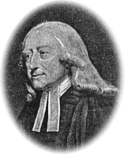Wesleyan Methodist Church (Great Britain)
| Wesleyan Methodist Church | |
|---|---|
| Classification | Protestant |
| Theology | Wesleyan |
| Governance | Connexionalism |
| Region | Great Britain |
| Founder | John Wesley |
| Merged into | Methodist Church of Great Britain |
The Wesleyan Methodist Church was the name used by the majority Methodist movement in Great Britain following its split from the Church of England after the death of John Wesley and the appearance of parallel Methodist movements. The word "Wesleyan" was added to the title to differentiate it from the Welsh Calvinistic Methodists, founded by George Whitefield who, like Wesley and his brother Charles, had been a member of the Holy Club in Oxford to which the (originally derogatory) epithet "Methodist" was first applied, and from the Primitive Methodist movement, which separated from the Wesleyans in 1807.[1] The Wesleyan Methodist Church followed the Wesleys in holding to an Arminian theology, as against Whitefield's Calvinism; its Conference was also the legal successor to John Wesley as holder of the property of the original Methodist Societies.[2]
John Wesley was convinced of the importance of education and, following the advice of his friend Dr. Philip Doddridge, opened schools at The Foundery in London, and at Newcastle and Kingswood. Following the upsurge in interest in education which accompanied the extension of franchise in 1832, the Methodist Conference commissioned William Atherton to report on Methodist schools, coming to the conclusion that if the Church were to prosper the system of Sunday schools (3,339 in number at that time, with 59,277 teachers and 341,442 pupils) should be augmented by day-schools with teachers educated to high school level. The Rev. John Scott [3] proposed in 1843 that 700 new Methodist day-schools be established within seven years. Though a steady increase was achieved, that ambitious target could not be reached, in part limited by the number of suitably qualified teachers, mostly coming from the institution founded in Glasgow by David Stow. The outcome of the Wesleyan Education Report for 1844 was that planning began for permanent Wesleyan teacher-training college, resulting in the foundation of Westminster Training College at Horseferry Road, Westminster in 1851, with the Rev. Scott its first Principal.[4]
In 1897, Reginald Perks, MP for Louth in Lincolnshire, proposed the creation of the Wesleyan Methodist Twentieth Century Fund (also known as the 'One Million Guinea Fund') which aimed to raise one guinea (£1.1s. or £1.05) from each of the one million Wesleyans to purchase the former Royal Aquarium and Winter Garden site in central London to build a world centre of Wesleyan Methodism and to expand the mission of the Wesleyan Church at home and overseas.[5] On 8 November, 1898, the fund was officially launched at Wesley's Chapel in City Road, London, and raised the funds to pay for Westminster Central Hall and to support construction and extension of other Wesleyan Methodist churches and sunday schools around the UK and overseas.[6]
The title "Wesleyan Methodist Church" remained in use until the Methodist Union of 1932, when the church re-united with the Primitive Methodist Church and the United Methodist Church to form the current Methodist Church of Great Britain.
See also
References
- ↑ Molland, E. (1959) Christendom. London: A. R. Mowbray; pp. 267-70
- ↑ Davies, R. E. (1985) Methodism, 2nd ed. Peterborough: Epworth Press. ISBN 0-7162-0280-8; p. 109.
- ↑ John Scott (1792–1868) was grandfather of John Scott Lidgett
- ↑ F. C. Pritchard The Story of Westminster College 1851–1951 London: The Epworth Press 1951
- ↑ History - Methodist Central Hall, accessed 6 November 2016
- ↑ The Wesleyan Methodist Twentieth Century Fund, from The Barwicker No. 74, June 2004, accessed 6 November 2016
